V
|
|

 |
Venturia oleagina (a rare pathogen) 
Feb 9, 2024. Having just learned from a friend about this much under-recorded species recently found - one which occurs on Olive leaves and first recorded in the UK by Asco expert Brian Spooner in 2010 - Jesper Launder went searching on all the Olive trees he could find in Gerrards Cross. He eventually discovered it outside a restaurant! This is new to the county and the name is as yet not accepted in Species Fungorum or Index Fungorum; apparently extremely few records exist. So if you know of an Olive tree this species is well worth checking for now.
|





 |
Verpa conica (Thimble Morel)
Apr 8, 2024. Near Saunderton Sarah Ebdon spotted a likely piece of habitat for this relative of the Morels and was rewarded with a couple of specimens. The tall stem with relatively small head is not unusual with this distinctive species which here is showing nicely why its English name was chosen. The comments written for the entry below apply just as aptly for this springtime fruiter.
Apr 8, 2023. In Salden Wood under Hawthorn Bob came across this singleton, a species we also found at Rushbeds Wood on April 2nd and one which seems to be appearing in quite a few place now. Though a species of Morel, it lacks the typical honeycomb cavities of the Morchella genus having instead a rather wrinkled outer surface, hence its different genus. We have a handful of county sites where it's been found, and though not rare this is a first for Finds. Photo 2 shows a fully mature specimen and was found 9 days later in Gerrards Cross by Jesper Launder. Photo 3, taken 10 days later, was sent to Penny by BBOWT Ecology Officer Andy Coulson-Phillips for identification and was found amongst the bluebells at Finemere Woods. He said there were a dozen or so within a few meters square. Photo 4 was a singleton found by Penny at Rushbeds Wood on April 24th. Photo 5 was taken by Philip Townsend on April 29th at Ragpits BBOWT Reserve.
|
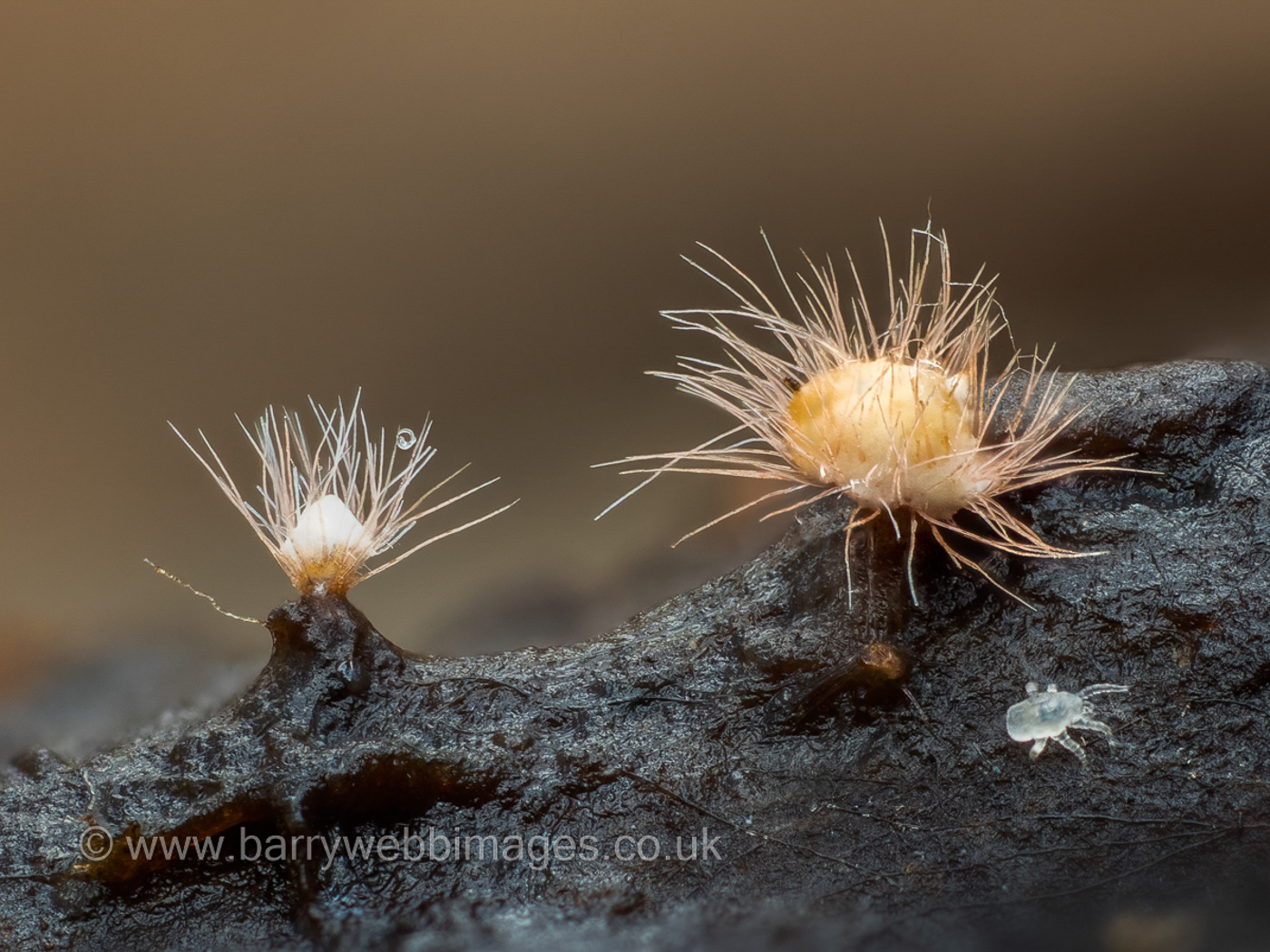 |
Volutella ciliata (an Ascomycete with no common name)
April 6, 2021. Barry Webb found these tiny rarely recorded Ascos in Burnham Beeches on a woodchip pile. Described as occurring commonly on herbaceous stems, this is a first for the county - presumable not spotted previously owing to it being so tiny, each cup measuring only 0.25 mm across! The species name ciliata refers to the obvious long fine hairs around the periphery which make this amazing fungus so distinctive despite its miniature size.
|
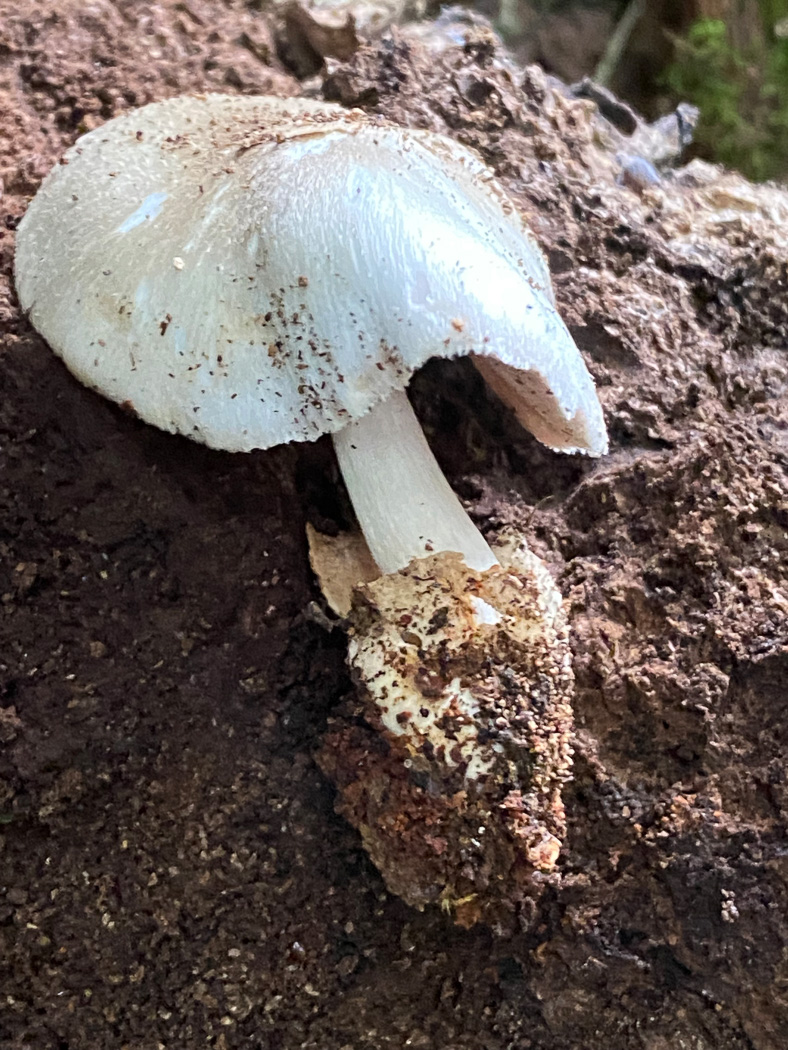
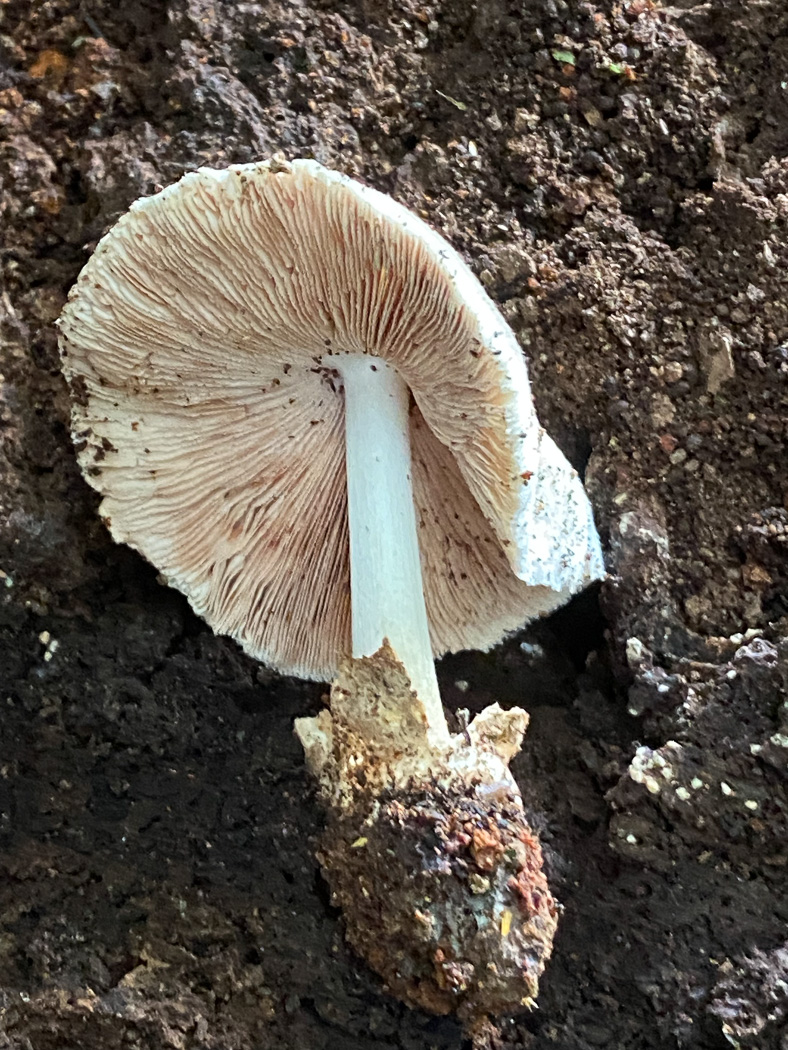
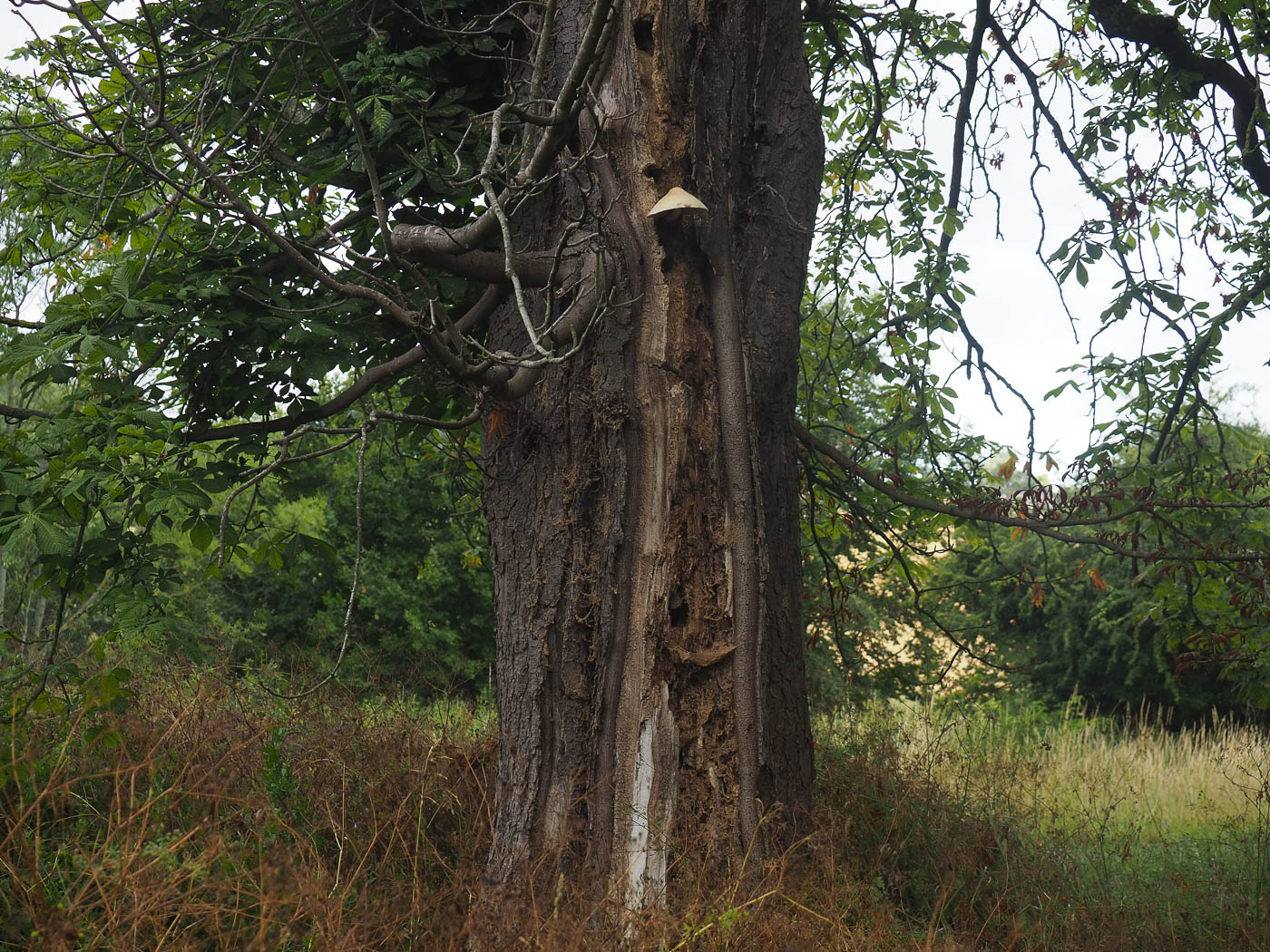


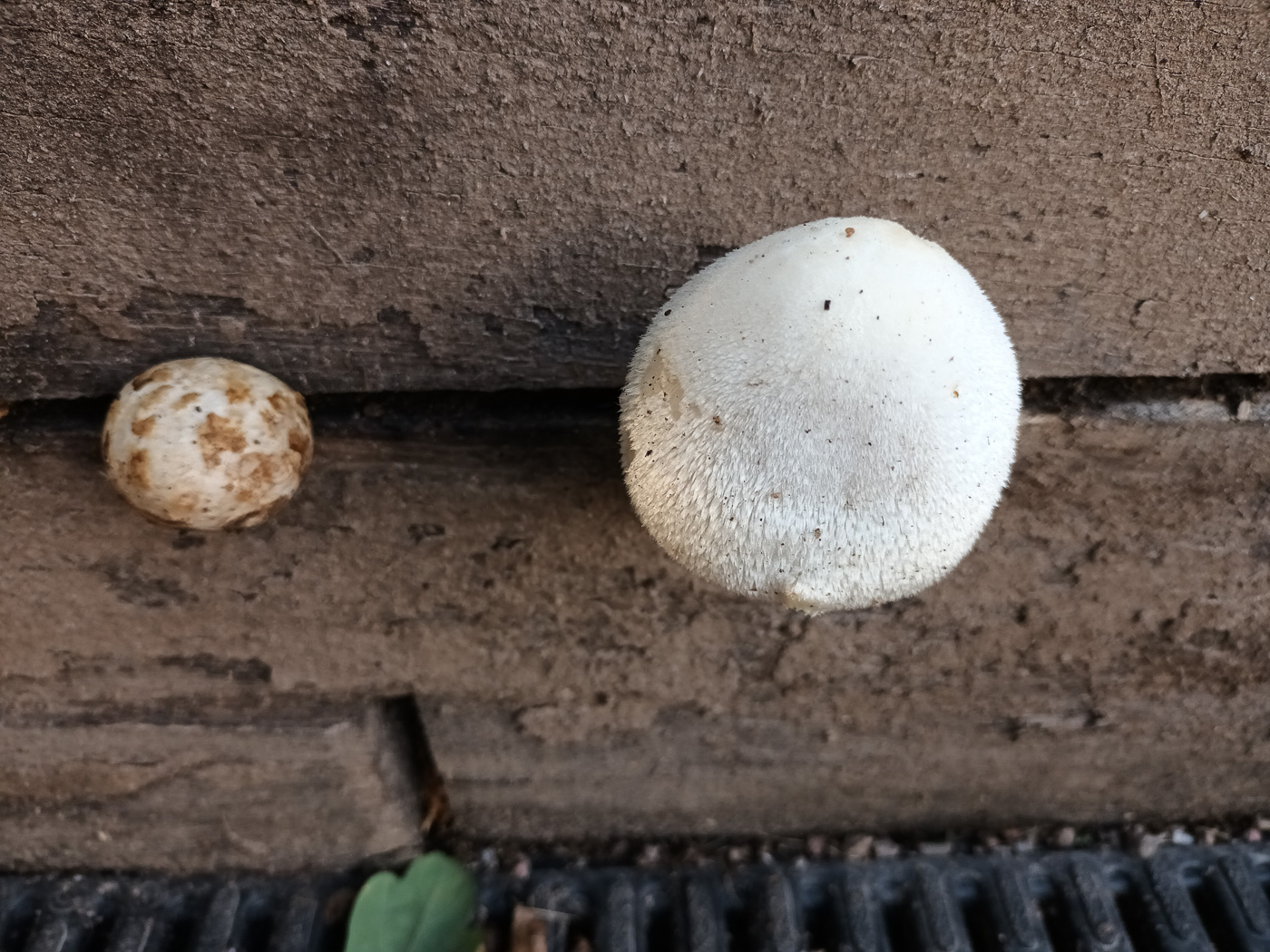
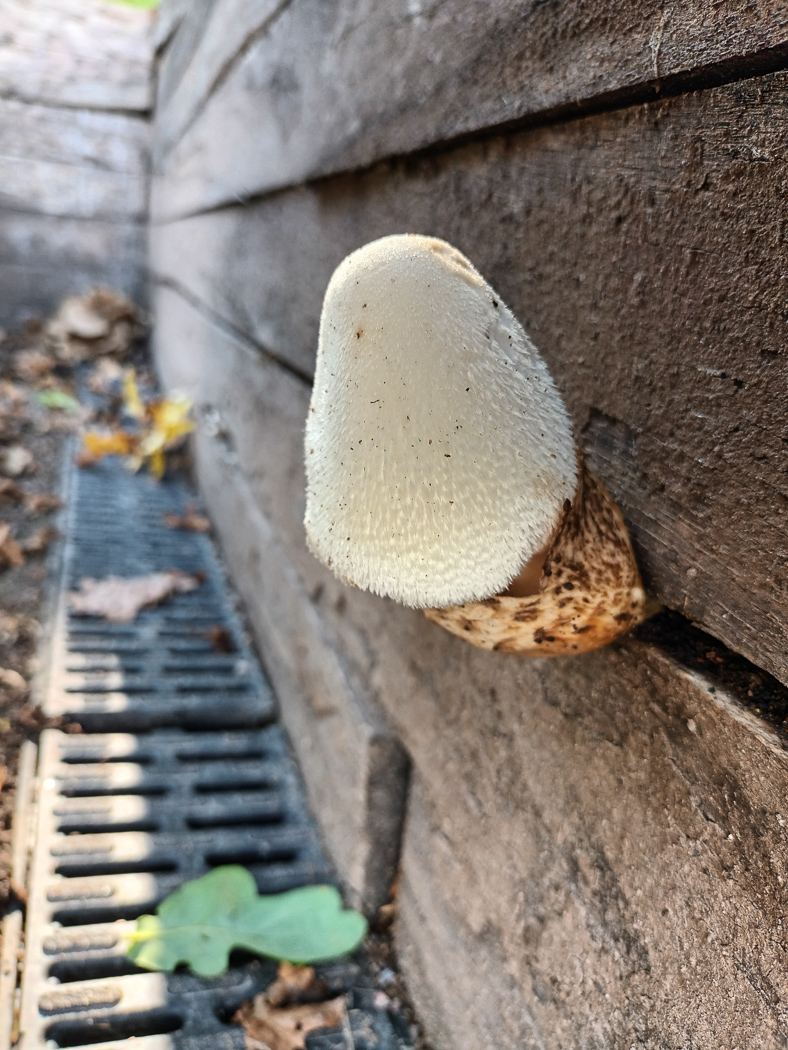
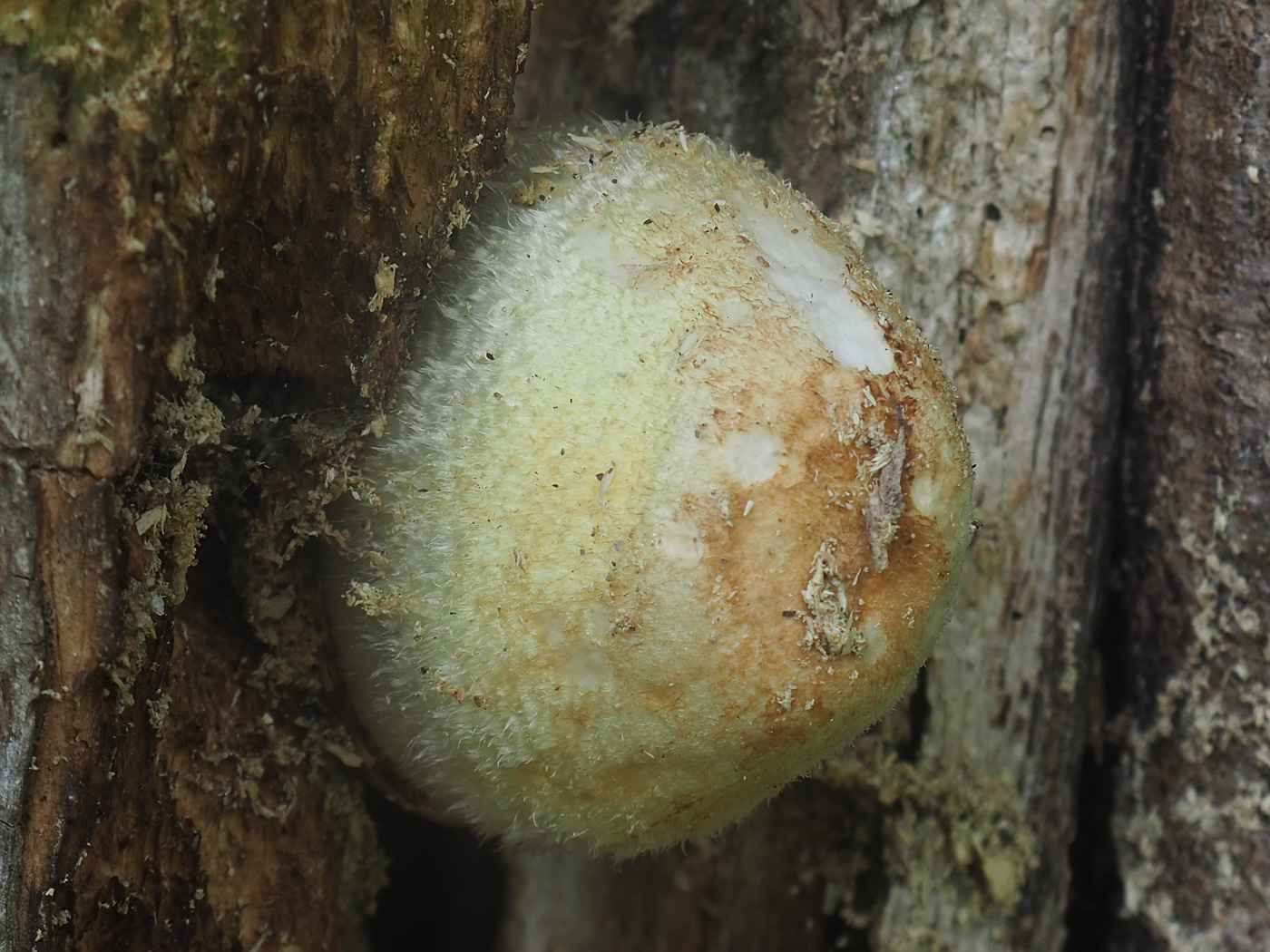
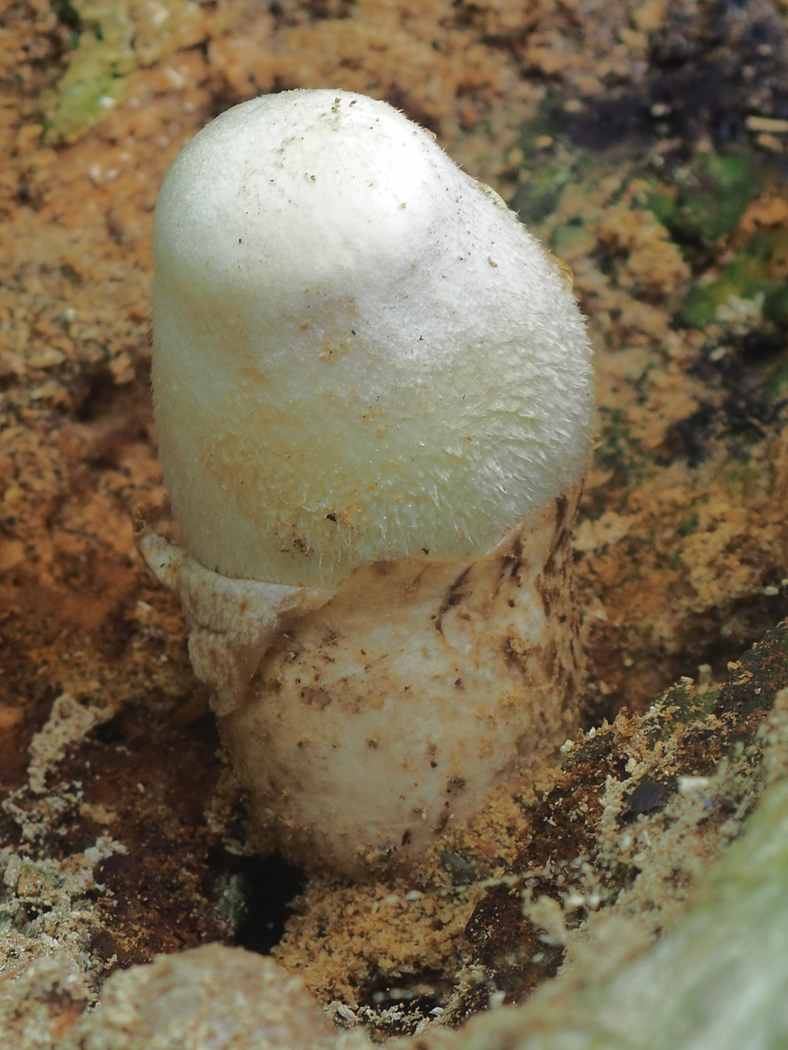
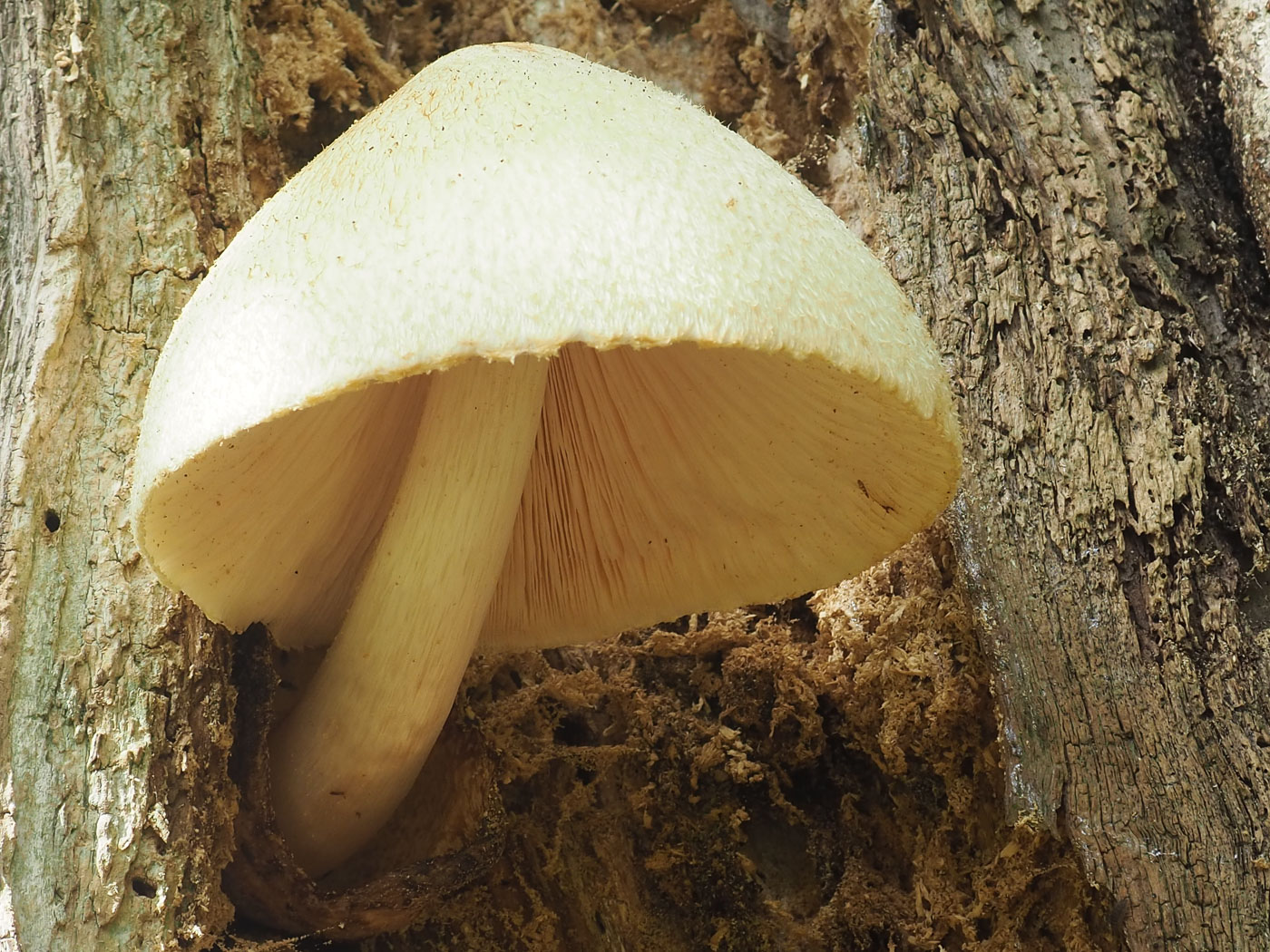 |
Volvariella bombycina (Silky Rosegill)
Sep 20, 2024. On a fallen deciduous trunk in Bernwood Forest Chris Grimbly spotted this unusual species. The easiest way to describe it is very similar to a species of Pluteus - ie on wood, with pink free crowded gills - but with one clear difference: it has a Grisette-like volva at the stem base. This feature can be fragile and sometimes easily lost leaving the ID in doubt, but the cream cap colour together with fine silky hairs should be sufficient to alert one to its identity.
Jul 7, 2023. In Hughenden Park John Catterson spotted this beautiful specimen about 9-10 ft up on a decaying Horse Chestnut trunk. He comments that he's found it fruiting here for the last two years though not as high up as this. (Two of our three previous Finds images are John's photos from this same tree.) This is an uncommon species, similar to Pluteus (ie with free pink gills) but the genus name describes the difference: it has an Amanita-like volva at the stem base which though submerged within the wood here can just bee seen in photo 3.
Sep 27, 2021. On Beaconsfield Golf Course, Jesper Launder was pleased to find these young specimens just emerging through a couple of planks. Not a common species - in some years hardly recorded - the slightly furry cream to white cap together with the stem arising from a volva (as in the genus Amanita) are the diagnostic features to look for, also the fact that the free gills are not white as in Amanita but gradually turn pink as in the genus Pluteus.
Jul 6, 2021. In Hughenden Park John Catterson found several fruitbodies of this interesting species just emerging in the decaying part of an otherwise living Horse Chestnut - the same tree where he discovered it last year (see in Finds 2020 dated Aug 28th). Closely related to the genus Pluteus with which it shares the pink spores and free pink gills, the key feature to look for in the field which separates it from that genus is the presence of a volva (sac) at the stem base, best seen in young material as here. This is the only member of its genus found on wood and can grow to a good size (over 12 cms across) and though not common it can safely be identified in the field by its combination of pale cap covered in coarse silky hairs together with the features already mentioned above.
Aug 28, 2020. John Catterson found this quite rare and beautiful fungus growing on Horse Chestnut in Hughenden Park, Wycombe. Similar to the genus Pluteus, which also occurs on wood and has pink free gills, the genus Volvariella has a 'volva' or sack similar to an Amanita at the stem base (not visible here being submerged within the wood).
|
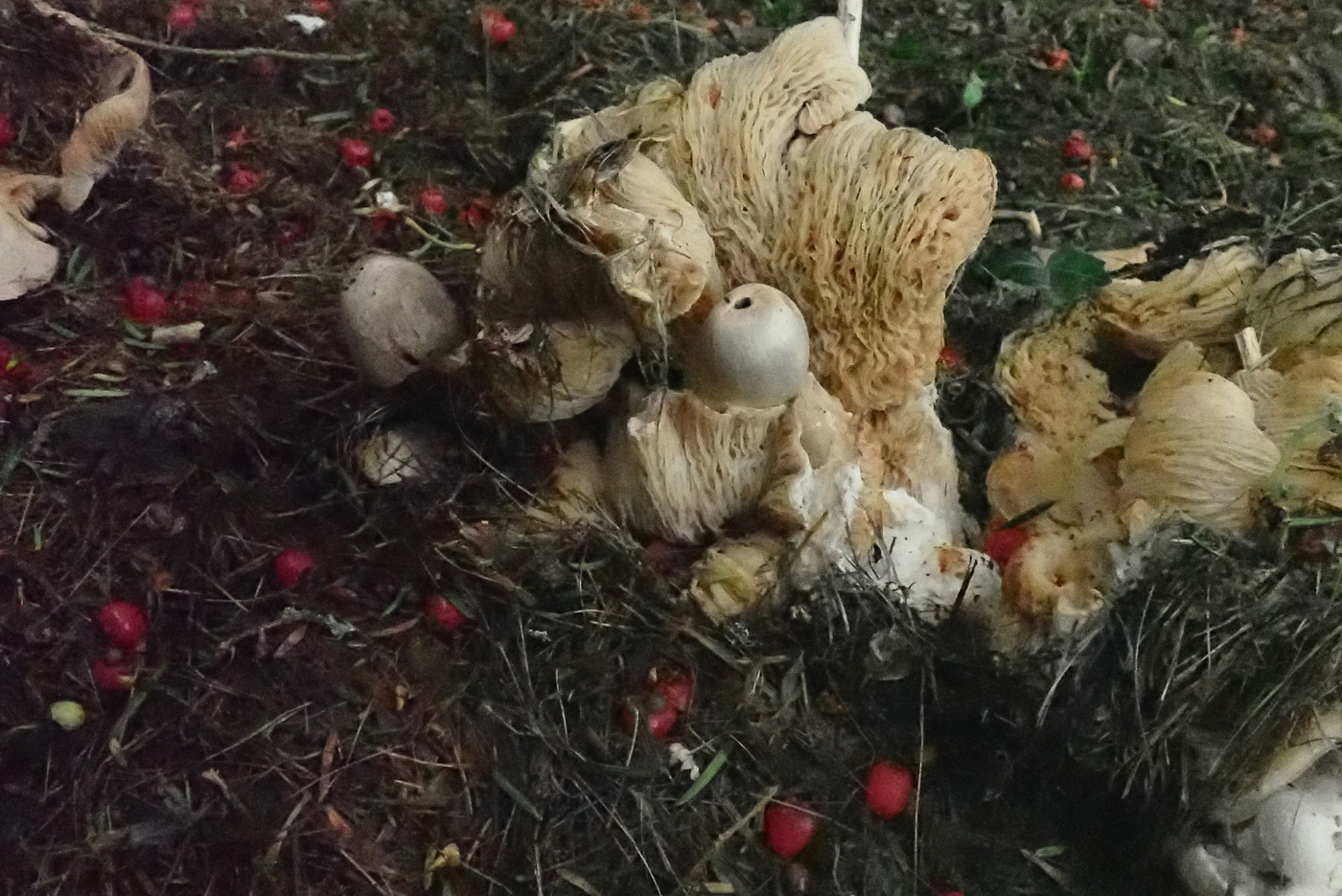
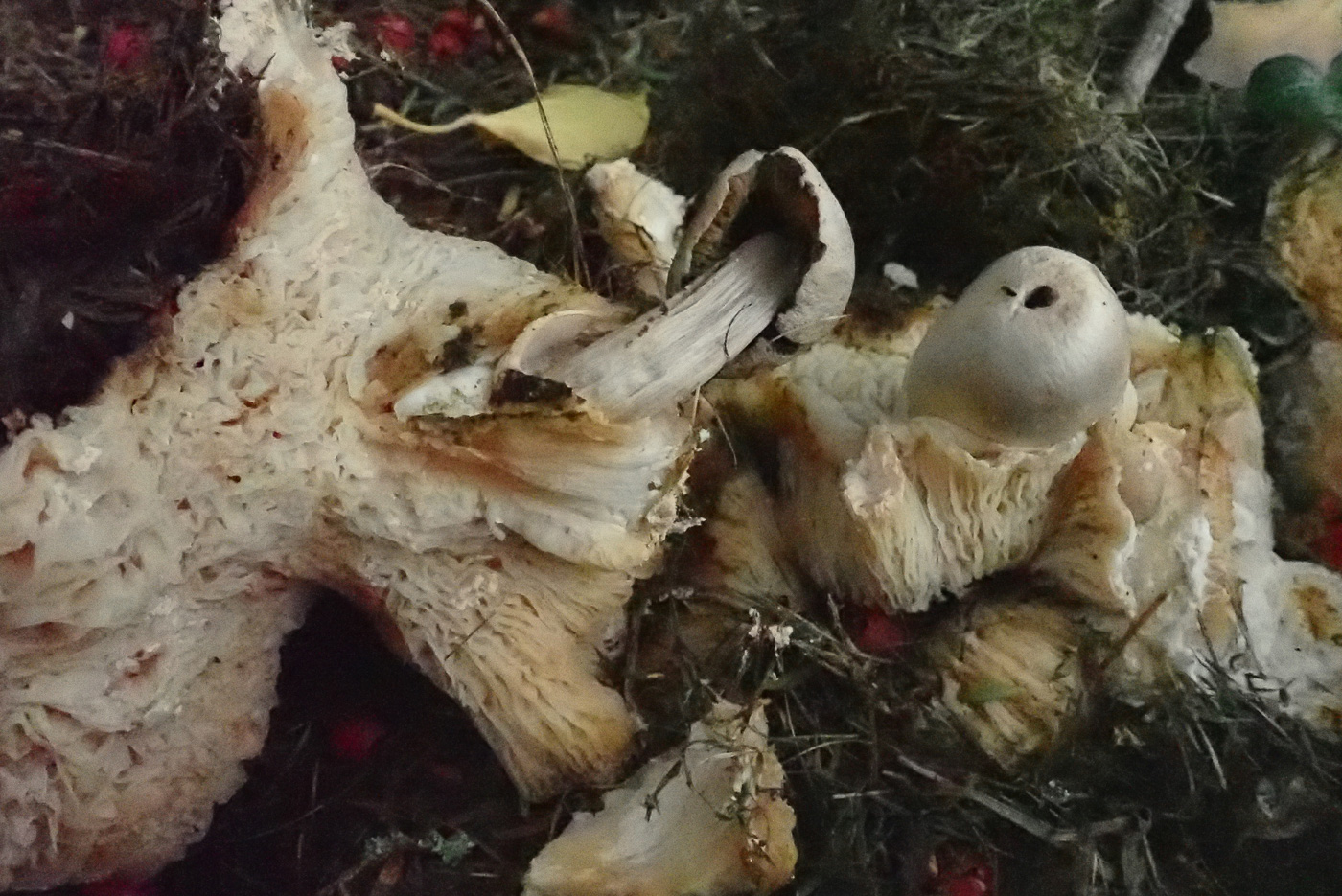
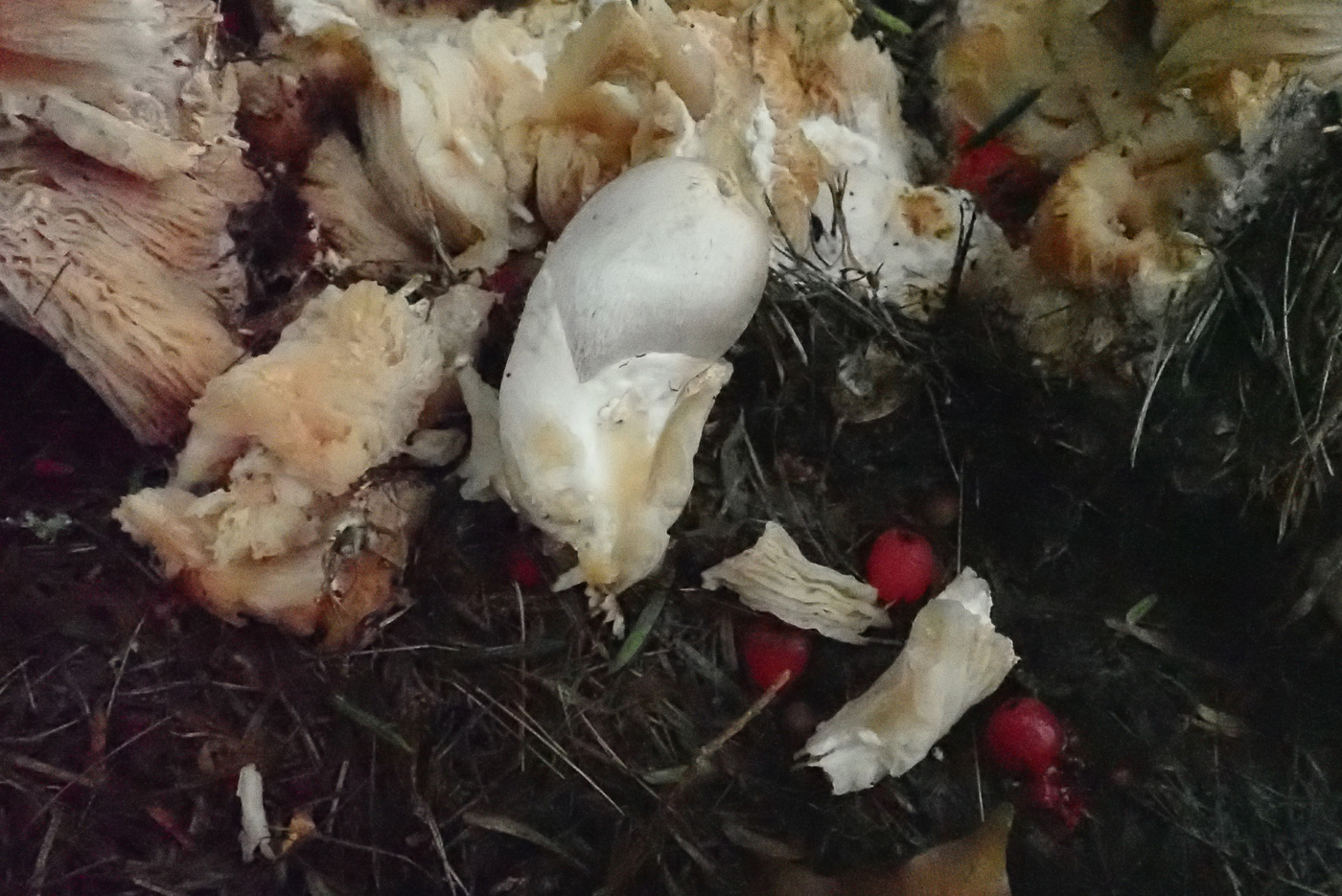
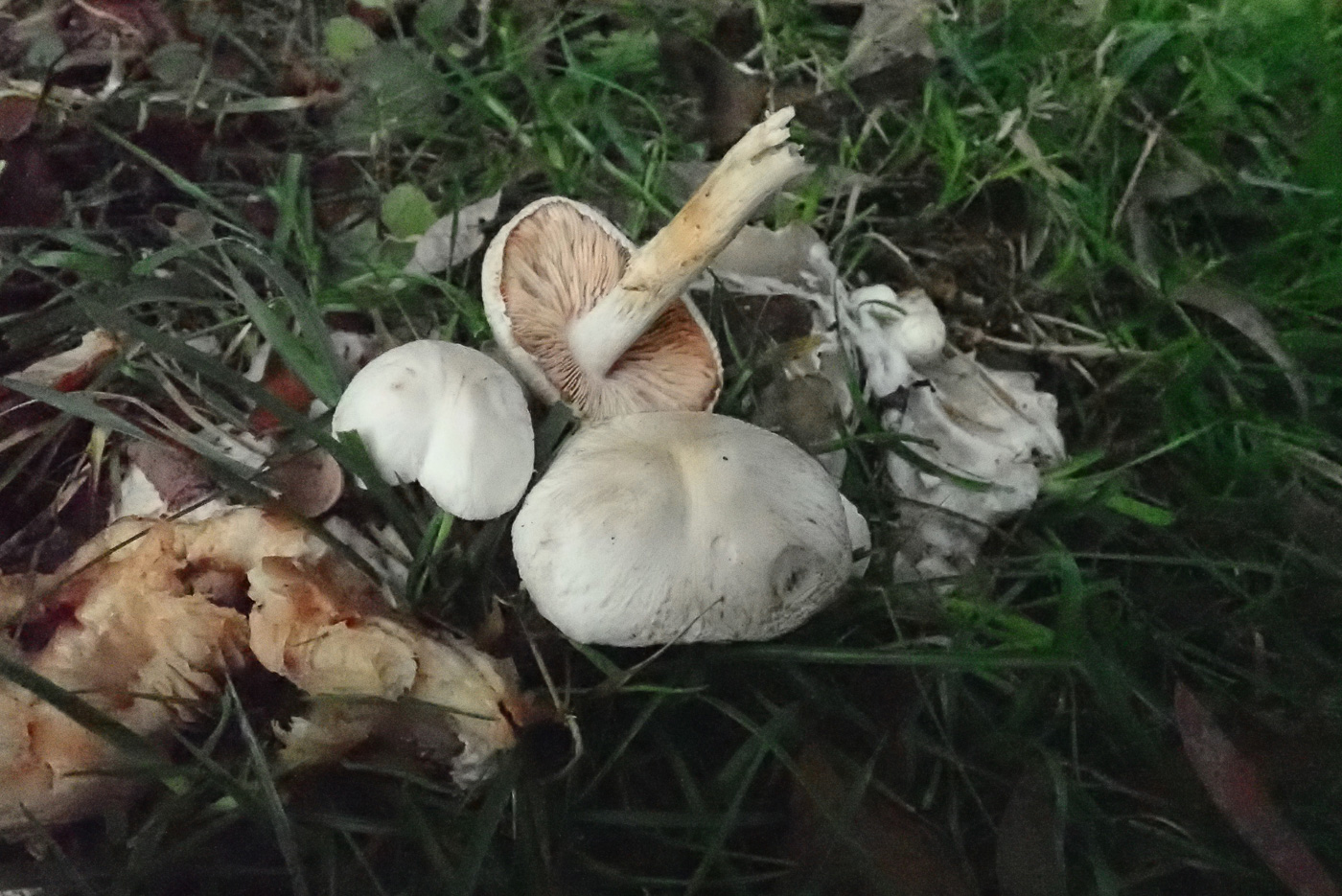 |
Volvariella surrecta (Piggyback Rosegill)
Dec 1, 2021. In Bradenham Churchyard Penny was delighted to find this rare and interesting species - one for which we have just a single previous county record from 2014. The common name is apt here: this is a mushroom growing on a mushroom and one which is completely dependent on its host species (Clitocybe nebularis - Clouded Funnel) for its existence, growing out of old rotting fruitbodies late in the season. Penny had found it a week ago but in Sussex, so realising that it might be fruiting locally at the moment she was on the lookout for it. There was a cluster of C. nebularis decaying on old lawn clippings dumped under a large Yew and there it was! Note the large volva it's emerging from - a diagnostic feature of the genus which otherwise is similar to Pluteus, ie having pink free gills. This is definitely one to look out for now wherever you come across the host mushroom well past its sell-by date.
|
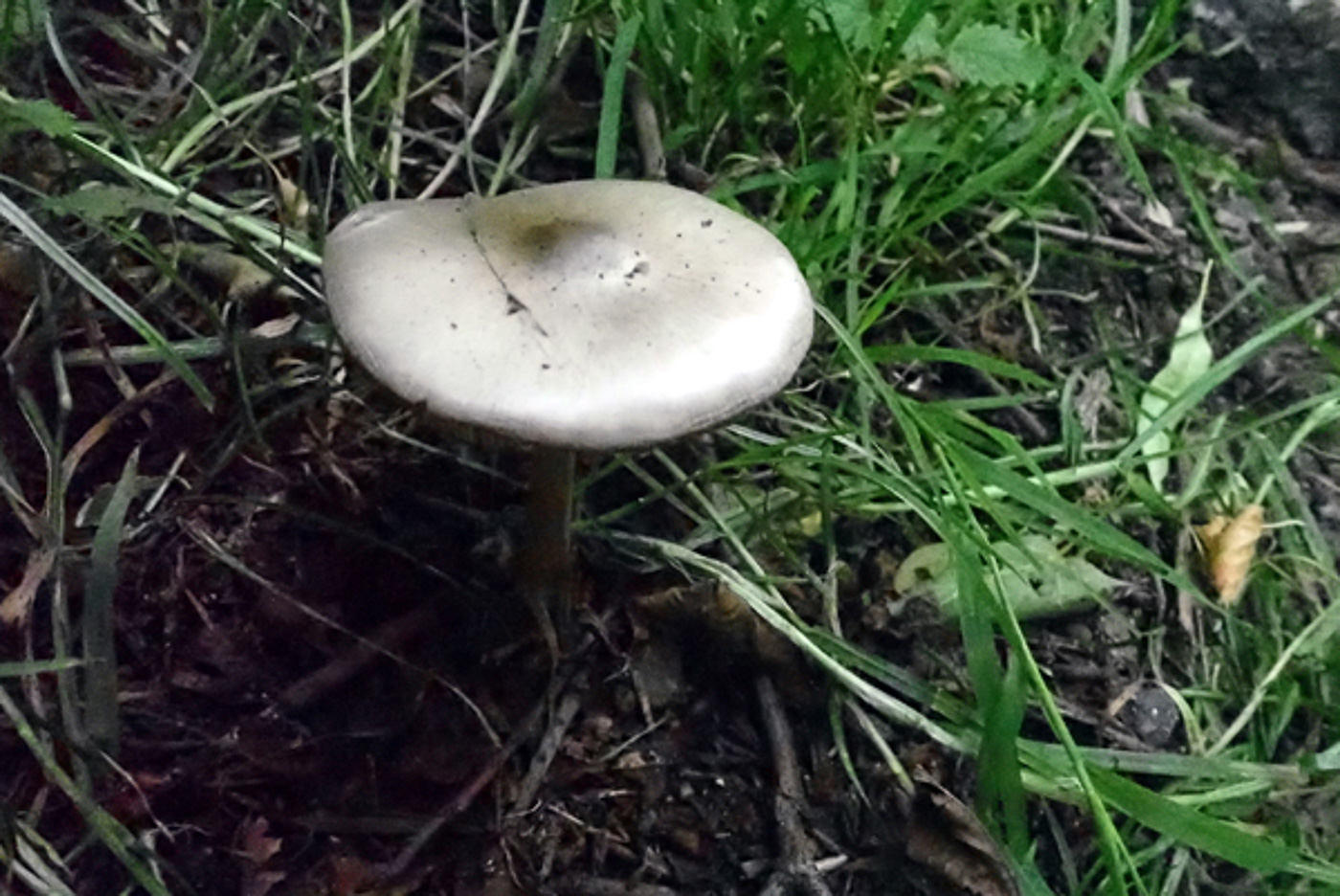
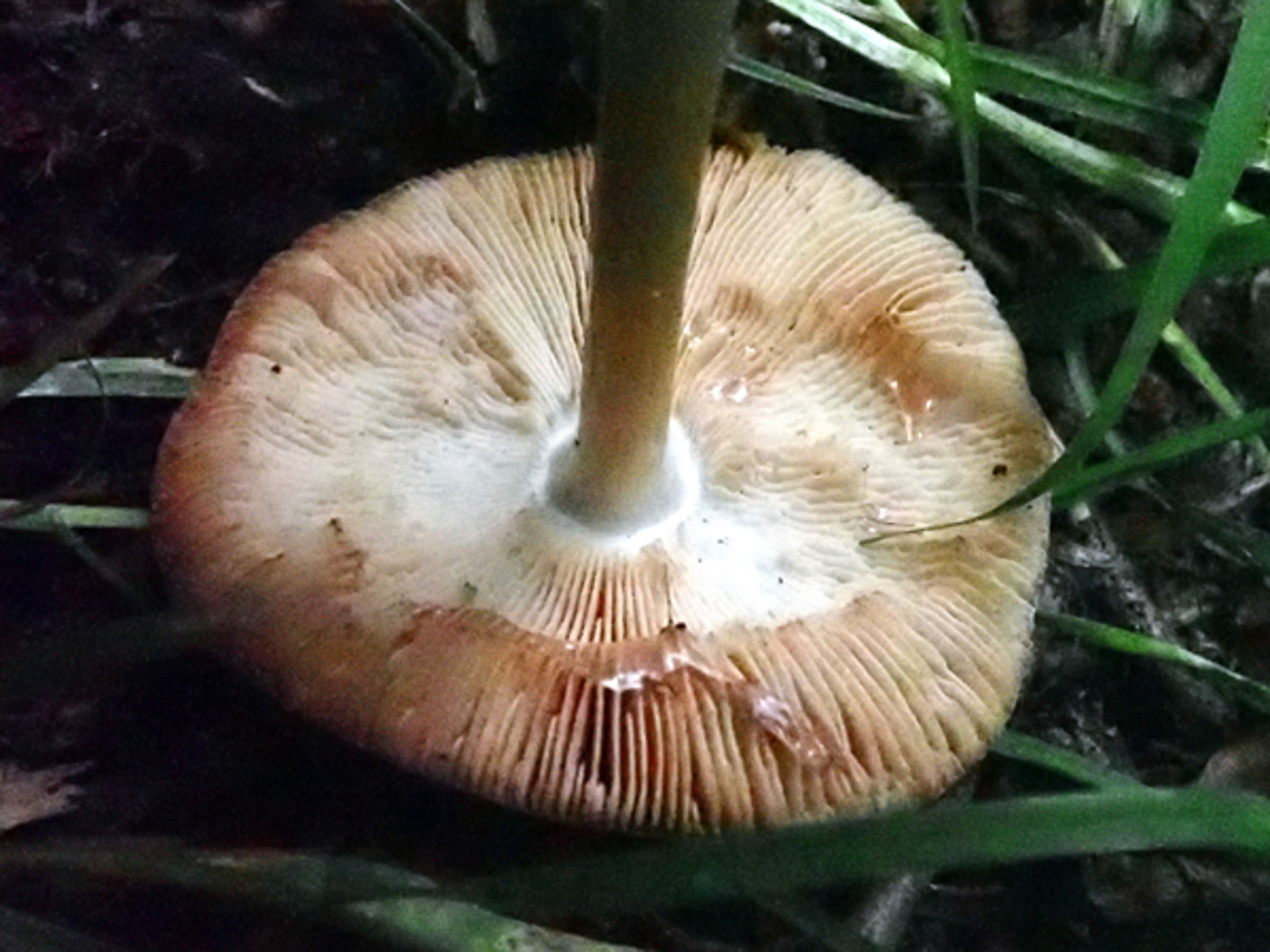
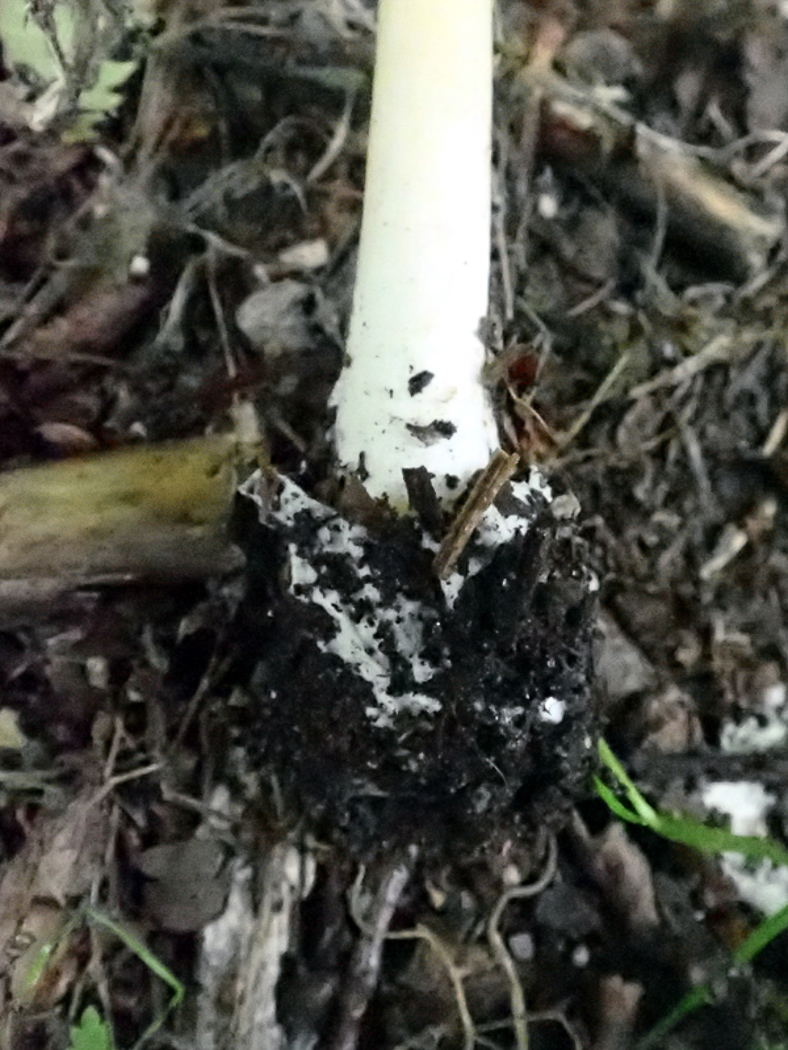
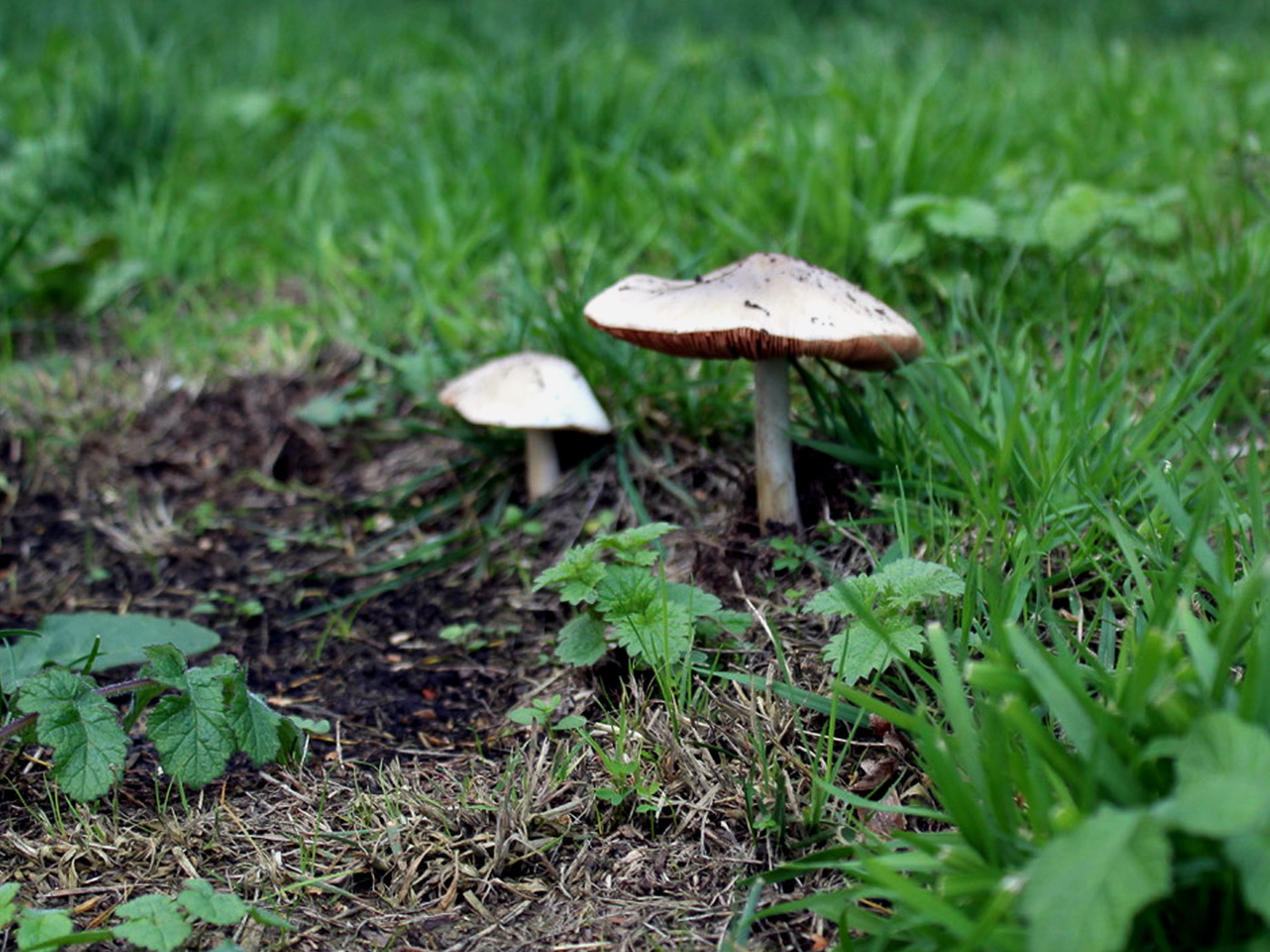
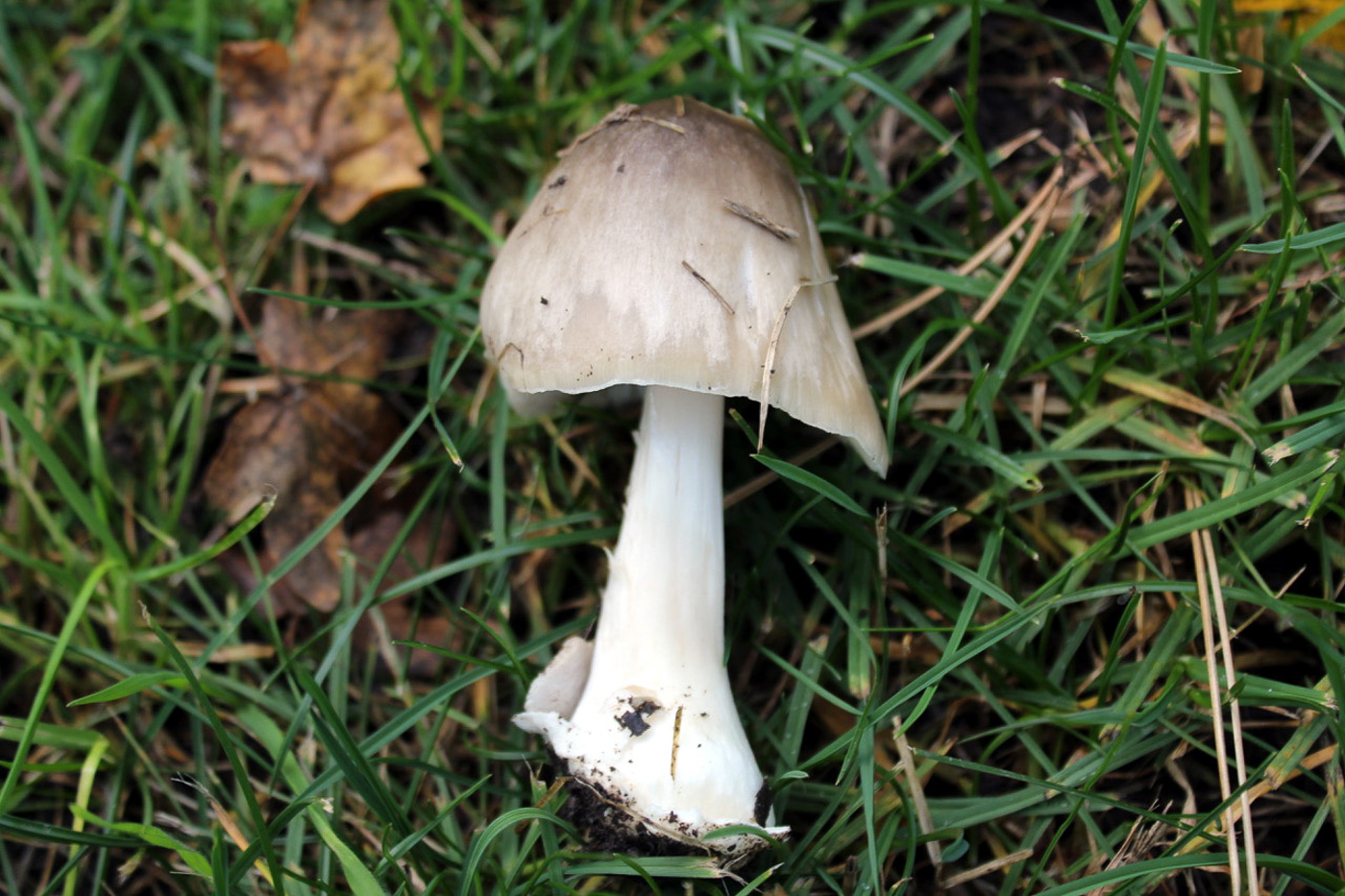
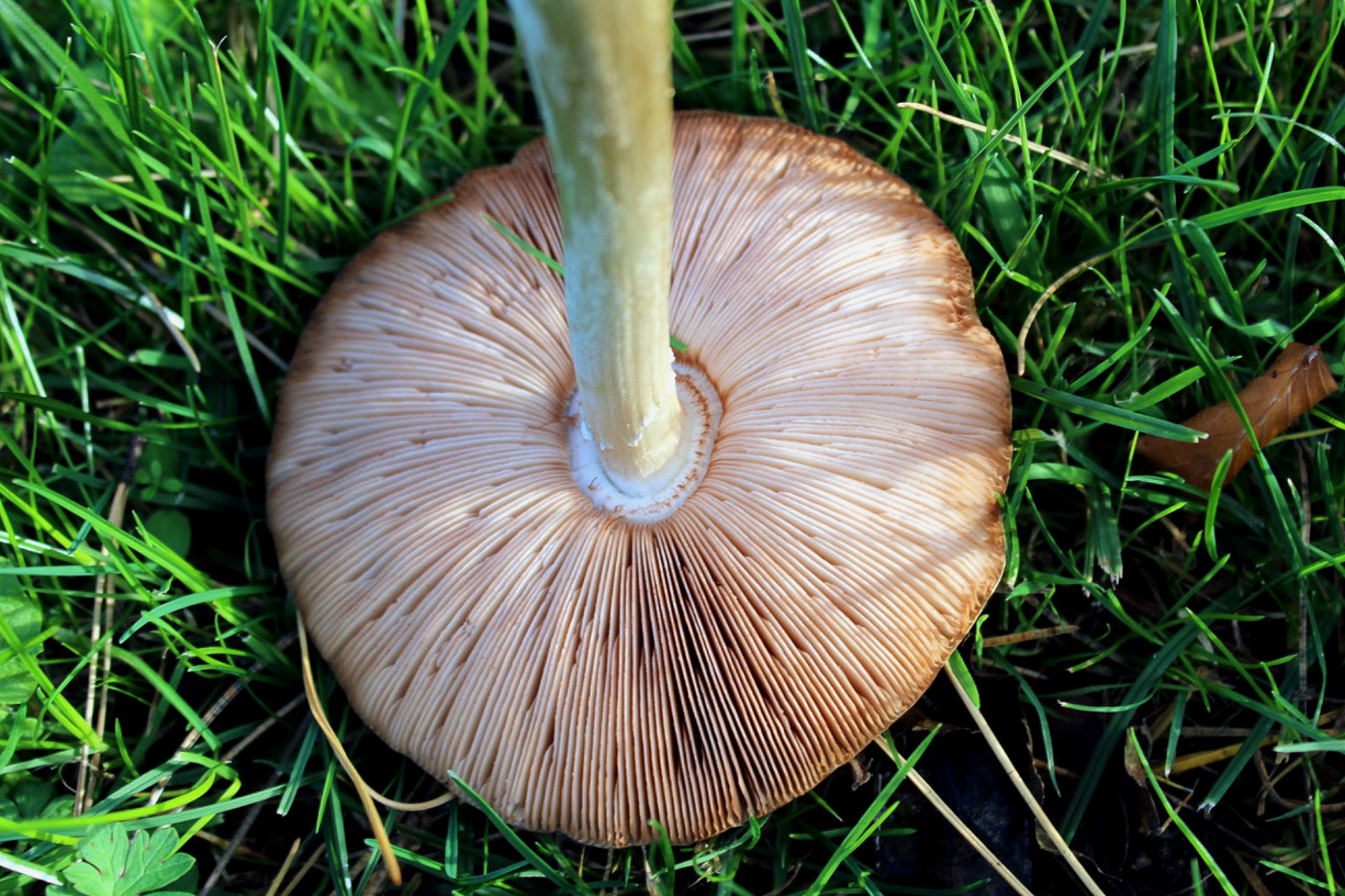
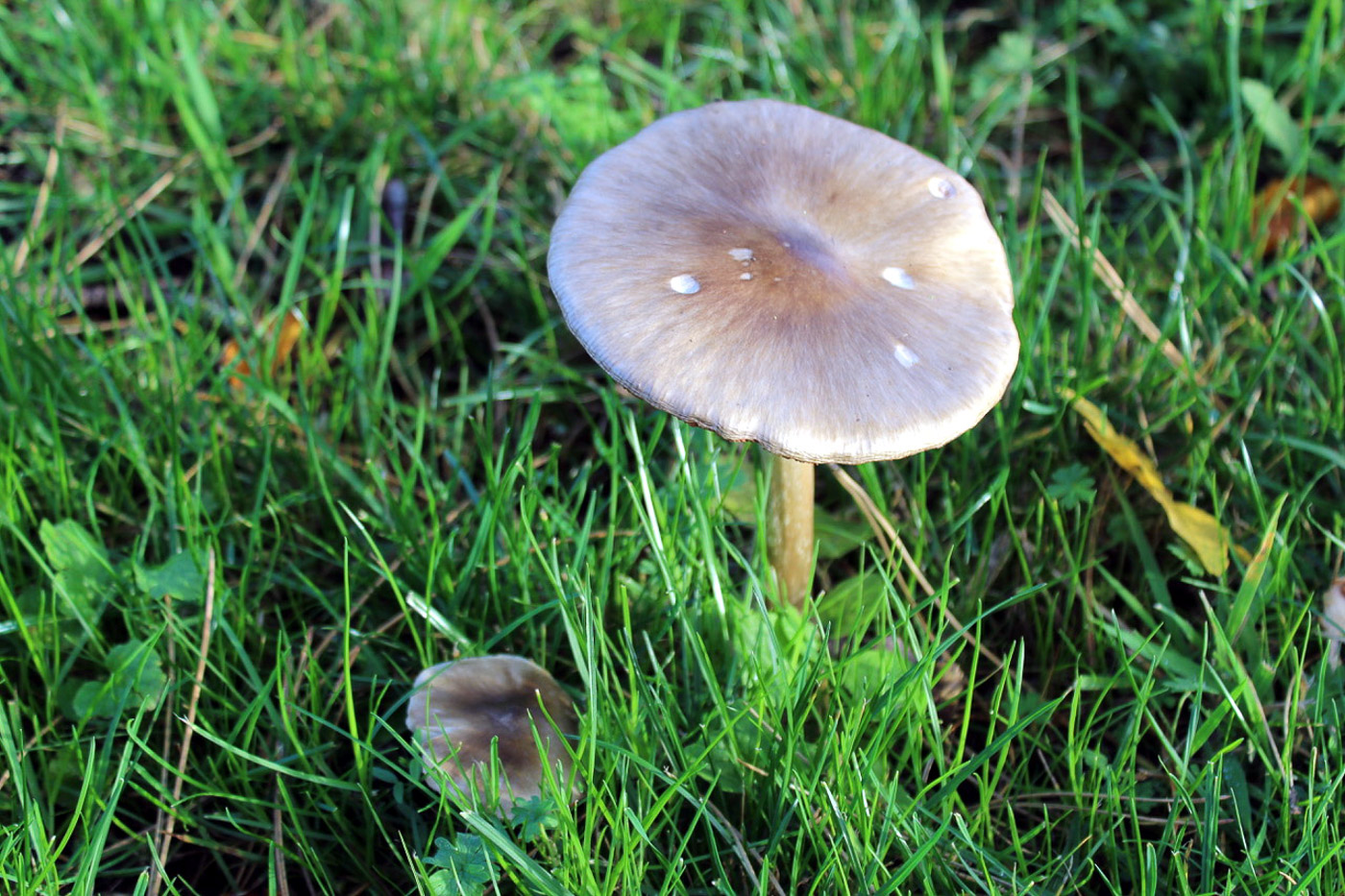
|
Volvopluteus gloiocephalus (Stubble Rosegill) 
Jun 13, 2022. In a grassy roadside only inches from the road at Turville Heath Penny was surprised to find this agaric which was about 6 cm across, the identity of which completed fooled her to start with. From above it appeared similar to maybe a Melanoleuca or even a Grisette Amanita, but on turning it over she then thought it must be a Pluteus, having pink crowded gills which were clearly free (photo 2). It was not until she noticed the rather muddy volva at the stem base (photo 3) that all was revealed. The species was previously in Volvariella but its new genus name is apt - like a Pluteus but with a volva. It also has considerably larger spores (checked today) which separates it from other members of Volvariella. It can sometimes be seen in hundreds in fields cleared of cereal crops - hence its common name, but also occurs quite commonly in grassy areas throughout summer and autumn. We have a couple of other June records for the county.
Nov 2, 2020.Rebecca Hiorns found this distinctive species in parkland in West Bletchley. As its common name suggests, this is a species of agricultural fields as well as grassland and can sometimes be seen in stubble field in 100s. The genus (a few species of which have recently been moved to Volvopluteus) is very similar to Pluteus, having the same pink gills which are free of the stem apex (see photo 3). The main difference - which it's easy to miss unless you collect the stem base very carefully - is that the stem has a fragile membranous volva, similar to the Vaginatae group of Amanita species. In fact in early stages before the gills have turned pink, this species looks extremely like A. vaginata with its grey smooth cap. However, the cap is sticky and lacks the radial striations of that species, also it does not associate with trees. In any case once mature there is no mistaking the pink gills. This is a large species with caps getting to 15 cms across and stems even taller than that. Compare with V. bombycina dated Aug 28(!) which is absolutely nothing like this species at all!
|
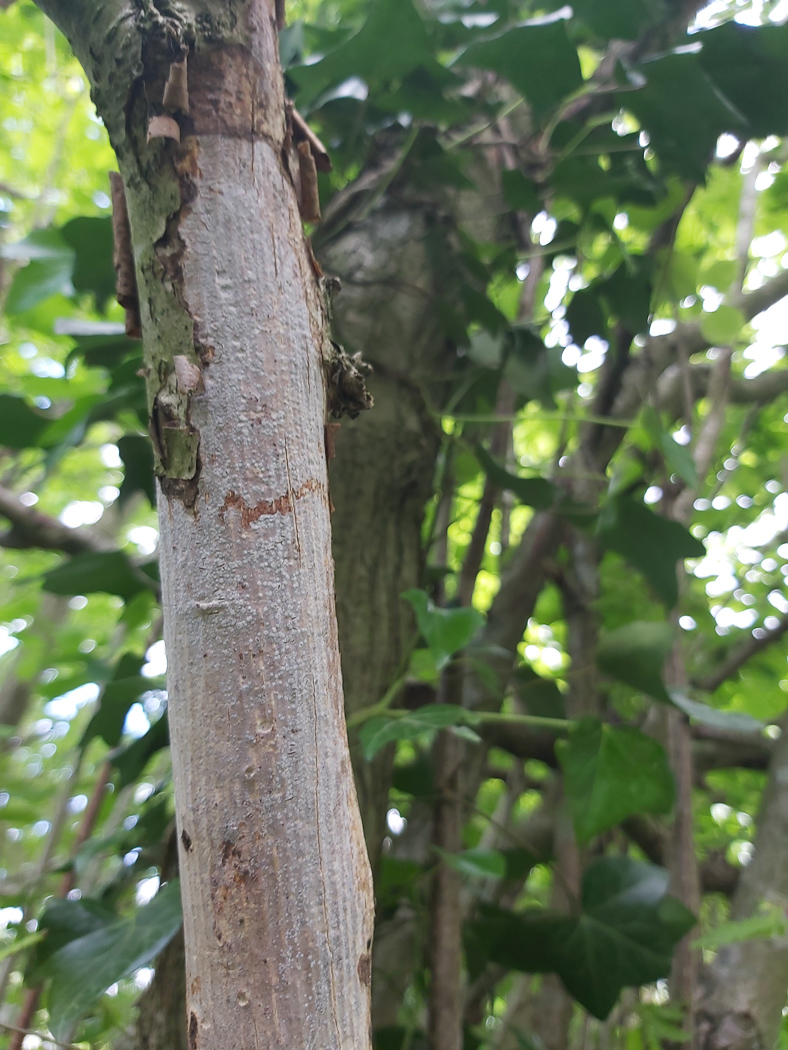 |
Vuilleminia coryli (a corticioid fungus with no common name) 
May 26, 2021. At Oakland Park Golf Course Jesper Launder noticed this patch of fungus spreading smoothly over a Hazel branch. It is somewhat similar to the many other corticioid fungi but is found mainly on Hazel (also on Hawthorn and Dogwood) and has a soft waxy slightly pinkish surface but needs examination with a scope to make the determination secure. Apparently quite a common species, we have around 10 county records.
|
































